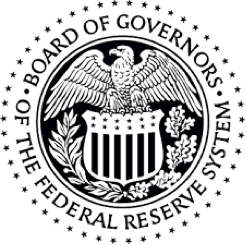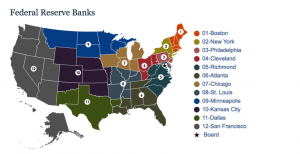Theory and Mechanics
By Tyler Grosse
Because no one entity can regulate all financial markets at the same time, central banking systems operate to control monetary supply of their respective currencies and manage inflationary pressures by directing interest rates. Thus, central banks must monitor the international markets to ensure balance and stability in supply and in exchange. Great Britain’s Bank of England and the United States’ Federal Reserve are two sovereign government’s central banking systems worth examining.
Exhibit 1: Federal Reserve Seal Exhibit 2: Bank of England Seal
The U.S. central banking system is known as the Federal Reserve, or The Fed. While the Bank of England was formed in 1694, the Federal Reserve System was established by the Federal Reserve Act of 1913, also known as the Owen-Glass Act. The bill called for separate but mostly autonomous regional banks called Reserves, supervised by a board appointed by the President of the United States (A Brief History of Central Banking in the United States – Edward Flaherty). Its primary purpose was to create a “lender of last resort” hopefully preventing the series of crippling bank runs and ensuring financial crises that had plagued the nineteenth century economy.
THE FEDERAL RESERVE BOARD
Today, the Fed manages monetary policy, regulates banks and their holding companies, and monitors systemic risk. Former Fed chairman Janet Yellen was recently replaced by Jerome Powell as chairman of the seven members of the Board of Governors. Each of the seven members is President-appointed and Senate-confirmed. This group is a part of the larger Federal Open Market Committee, which makes up 12 seats, including the Board of Governors as well as five of twelve rotated regional bank presidents. The [sobriquet] FOMC manages interest rates and monetary supply. (Council on Foreign Relations)
The Fed was established to a) maintain stable prices and b) achieve full employment. [note: Generally, “full” implies a 4-5% unemployment rate]. In order to do so, the Fed varies the Fed Funds Rate. This target controls the rate commercial banks can lend to other commercial banks.
TAYLOR RULE
The Taylor Rule is a formula developed by the Stanford economist in 1993 and is considered the present benchmark that economists use to evaluate Fed policy. It instructs that high inflation or employment rates mean interest rates should be raised, and rates lowered in times of low inflation. Taylor’s thesis is that housing price inflation, which incited the mortgage crisis, was exacerbated by loose monetary policy by the Fed in the early 2000’s. Thus, it is a main function of The Fed to control interest rates. Economists and the Fed now look toward “low, stable inflation” as a goal moving forward.
Exhibit 3: Federal Reserve Regional Banks
BANK OF ENGLAND
Likewise, the Bank of England sets and controls interest rates with their own version of the federal funds target rate. The rate of interest paid on reserves held by English commercial banks is called the “bank rate” or “base rate.” It is set by the Monetary Policy Committee (MPC) of the Bank of England. The Governor of the Bank of England is Mark Carney, he has served in this role since 2013 and has announced that he will serve until 2019.The Bank is overseen by the Court of Directors, those recommended by the Prime Minister and appointed by the Queen. In addition to the governor, there are three Deputy Governors for Monetary Policy, Financial Stability, and Markets and Banking, a Chief Economist in addition to the four external members appointed directly by the Chancellor. (BankofEngland.co) The policymaking committees include the Prudential Regulation Committee and Financial Policy Committee in addition to the Monetary Policy Committee.
FUNCTIONS OF NATIONAL AND CENTRAL BANKS
Central Banking Systems have two main functions in the current economic environment: first, to maintain monetary stability, and second, to act as “Asset Purchasing Facilities” (Bank of England’s terminology) for Quantitative Easing.
Central Banks maintain monetary stability by modifying the actual supply of money. A central bank would do this by purchasing debt or selling debt; thereby, respectively, increasing or decreasing the money supply to impact interest rates. (International Monetary Fund)
During the Great Financial Crisis of 2008-2009, the Fed and Bank of England alike lowered interest rates. Lowering rates to near 0 (as low as 0.25 percent Fed Funds rate) the economy was neither responding nor recovering (Fed Funds Rate History with Its Highs, Lows). [note: fed funds rates have been as high as 20% in 1980]. The central banking systems have been increasingly scrutinized with their response to this problem because of their massive undertaking of “monetary easing,” or the purchasing of government debt (treasuries) from commercial banks; thus increasing the money supply.
QUANTITATIVE EASING
Quantitative Easing (QE) is a policy used by central banks to purchase government securities or other securities from the market in order to lower interest rates and increase the money supply. Basically, the central bank artificially raises the price of bonds, because rates move inversely to price, to lower the lending rate.
Exhibit 4: Quantitative Easing, The Telegraph
Post-crisis, the Fed helped sustain the recovery through the unorthodox policy known as quantitative easing. by raising its total assets from $869 billion to nearly $4.5 trillion from 2007 to 2017. Conceptually, quantitative easing is intended to make more resources available to influence banks to be freer in lending and the public to continue to borrow (Council on Foreign Relations) After three rounds of QE (QE2 November 2010-June 2011, QE3 September 2012-October 2014), in order to stimulate the economy in the years following the 08-09 crisis. While economists agree that “monetary policy can’t alone solve economic problems,” the unconventional monetary policies enacted during the crisis were considered ultimately successful.
As rates have risen in the past few years, Janet Yellen’s Fed has announced the end of QE with a policy known as tapering to “unwind” the Fed’s massive balance sheet. While QE was ended by the Fed in 2014, it did not begin to unwind the $4.5 trillion balance sheet until October of 2017. Currently, it is said to be “gradually reducing” its holdings through 2018 in progressive monthly stages.
TAPERING
In the past, markets have responded poorly to fears of balance sheet tapering. Market volatility spiked in 2013 in response to the Fed’s discussion for potential tapering. According to economists and analyst Kristina Hooper, returning to normalized monetary policy is compared to “defusing a bomb.” Tightening could expose major weaknesses in the economy that were prolonged in financial bubbles by historically low rates and low exposure to credit risk that ensues as rates rise. Such low rates have encouraged immense accumulation of debt, which could make the economy especially susceptible to default risk. We have seen the occurrences of bubbles in financial markets for hundreds of years, possibly first seen in tulip mania, and later seen in the South Sea Trading Company, which imploded in 1720.
QE policy is intended to decentivize saving, by lowering the price to loan, and incentivizing spending, by raising the likelihood of paying for cheap debt, consumer spending and economic growth, especially during stagnant economic periods like the aftermath of the Great Financial Crisis. In the years following the 2009 crisis, the United States posted an average of 2.1% GDP growth, although the economy stagnated as late as 2016 with annual growth of just 1.6% (Bureau of Economic Analysis). In order to spur growth and control the risk of deflation, central banks eased monetary supply, effectively reducing interest rates until deflation concerns arose amidst short-term rates approaching zero. If interest rates are zero, it severely limits the central bank’s ability to consider further easing, implicitly driving negative interest rates. While it was hardly considered in the history of economies, monetary policy as an object of governmental regulation has only occurred since the 1600’s, however the introduction of negative interest rate policies by Japan between 2014 and 2016 broke traditional theory that guided international policy makers and central bankers alike.
ALTERNATE POLICIES
Central banks in developing countries, on the other hand, attempt to devalue their domestic currency in the foreign exchange market. They do so through purchasing foreign money using domestic currency. Such interventions are typically effective in devaluing currency but lead to surplus foreign exchange reserves (Basu). By keeping its currency relatively under-valued, exports should increase as exporters can charge lower prices and imports are discouraged because the value of the domestic currency is not as strong elsewhere.
SUMMATION
In summary, central and national banks play increasingly important roles in modern economics. They control the money supply, adjust interest rates, and control the Bank’s balance sheet. Central Banks like the Fed and the Bank of England attempted to stimulate growth after the Great Financial Crisis by purchasing trillions in government debt after the lowering of interest rates to near 0, as low as 0.25 percent, to “quantitatively ease” the economy back to normal. Banks, which were originally intended to dually maintain prices and alleviate unemployment, now have the added responsibilities of managing trillions of dollars of debt, regulating commercial banks and their holding companies, and managing systemic risk in the market. The National and Central Banks of Great Britain’s Bank of England and the United States’ Federal Reserve do so for their respective governments and have a tough task ahead of them: in unwinding trillions off their respective balance sheets without invoking or market turmoil or even recession.
Works Cited
Basu, Kaushik, 2009. “The Mechanics of Central Bank Intervention in Foreign Exchange Markets,” Working Papers 09-02, Cornell University, Center for Analytic Economics
Board of Governors of the Federal Reserve. “Board of Governors of the Federal Reserve System.” About the Fed, U.S. Federal Reserve, 2016, www.federalreserve.gov/aboutthefed.htm.
Desan, Christine. Making Money: Coin, Currency, and the Coming of Capitalism
James, McBride, and Sergie Aly Mohammed. “The Role of the U.S. Federal Reserve.” Council on Foreign Relations, Council on Foreign Relations, 2 Feb. 2018, www.cfr.org/backgrounder/role-us-federal-reserve.
“Monetary Policy and Central Banking.” IMF, International Montary Fund, 3 Nov. 2017, www.imf.org/en/About/Factsheets/Sheets/2016/08/01/16/20/Monetary-Policy-and-Central-Banking.
“Monetary Policy.” The Bank of England, Bank of England, 22 Mar. 2018, www.bankofengland.co.uk/monetary-policy.
US Department of Commerce, and Bureau of Economic Analysis. “Bureau of Economic Analysis.” U.S. Bureau of Economic Analysis (BEA), US Department of Commerce, www.bea.gov/index.htm.
“What Is Quantitative Easing?” The Economist, The Economist Newspaper, 9 Mar. 2015, www.economist.com/blogs/economist-explains/2015/03/economist-explains-5


